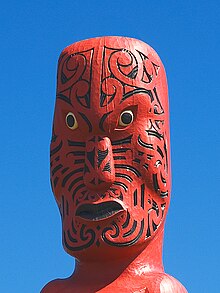Koru (symbol)

In New Zealand, Koru is theterm and symbol for the unrolling frond of the silver fern . The word comes from the Māori language, who traditionally used the symbol in paintings, carvings, jewelry and tattoos ,among other things. Today the koru symbol can be found in New Zealand art by both Māori and non- Māori . It is alsomarketedin the form of souvenirs and product labels and is often used in company logos. The Koru symbol often stands for New Zealand and a New Zealand identity .
Name meaning
On the one hand, ' koru ' is used in the Maori language for the unrolling frond of the silver fern. On the other hand, the term also stands for a bush plant in New Zealand, which is known under the Latin name colensoa physaloides and is preferably found in Northland . As a verb, ' koru ' can be understood as folded, looped or rolled up. In contrast, ' korū ' is understood to be shaken or shaken.
Use in traditional art
The symbol of the Koru , which is often found in the art of the Māori , is based on the unfurling frond of ferns and thus symbolizes the emergence of new life. The circular form also stands for a continuous movement, as well as the inward going spiral form, in this view, as the going back to the origin can be seen.
Carvings
Māori primarily use their carving art to design and decorate their wharenui (meeting houses), canoes and to represent human figures. Their origins can be found in the northern Polynesian Islands . In New Zealand, in addition to the Rauponga , Taratara o Kai , Unaunahi , or Ritorito and Pakura patterns, the carvings were often also given the Koru designs. The Koru representation was mostly based in a simplified manner on a curved stem with a round bulb at the end.
painting
Before Māori came into first contact with Europeans, painting was of rather subordinate importance compared to carving, tattooing or the creation of sculptures from bones and stones.
Paintings were mostly used within their meeting houses ( wharenui ), in which they were another important design element next to the carvings and the tukutuku (woven mats), or on paddles and the undersides of their canoes. In the meetinghouses, the roof beams and roof frames were preferably painted on the inside with Koru designs, which are traditionally referred to as Kowhaiwhai .
Ornamental Koru representations of varied ornate decorations were also used on the paddles of the canoes . Many of these paddles can be found in the British Museum , the Cambridge University Museum and occasionally in other museums, most of which were brought to Europe by Captain James Cook's research trips in the 18th century.
Tattoos
The Māori tattoos , called moko , differ from Polynesian tattoos in that they are cut rather than pricked. Every tattoo in different areas of the face has its meaning. Through the designs, the tattoo wearer shows what social rank he has, the status of his birth, his marriage, his authority and his personal mark, similar to a signature. The koru design in the tattoo is a small fraction of an intricate overall design.
Jewellery

The Māori preferred to make jewelry from Pounamu , a green-colored nephrite mineral, from bones or from the Pāua shell, which was mostly used as an eye in carvings. The shape of the Koru is only used for the Pounamu , which is also known as Greenstone in New Zealand . The predominant designs of the Koru are the single spiral, the double spiral or hook shape. The works of art made from the gemstone are usually worn as a necklace pendant. Most of the jewelry pieces are assigned mystical effects and meanings.
Use in contemporary art
A well-known artist in New Zealand who experimented with the Koru symbol in his works of art was Gordon Frederick Walters (1919–1995). He began to work with the Koru motif in 1956 and found his own style and interpretation between 1958 and 1959. His work was first exhibited in 1966 at the New Vision Gallery in Auckland . Since then, Walters has been seen in connection with the Koru .
Commercial use today
Since the Koru symbol is now firmly linked to the identity of the country New Zealand, it has been found for some time in a variety of ways on company logos, on publications, advertising material and wherever one would like to identify with New Zealand.
For example, Air New Zealand , New Zealand's national airline, has a stylized Koru design in its company logo. The Koru symbol was first used in 1973 on the tail fins of the new DC-10 fleet. The company logo has been changed twice since the company was founded. Despite changes in color and font, the Koru design has held up to this day. The Koru symbol is also often found in government institutions or ministries, such as in the logo of the Ministry of Māori Development ( Te Puni Kōkiri ).
Flag of the Māori
In January 2009, Pita Sharples , Minister for Māori Affairs at the time , declared that the Māori flag should fly from Auckland Harbor Bridge on Waitangi Day . His idea that the symbol of this flag could serve to improve the relationship between the state and Māori . After a public tender and the choice of the design concept, the design of the Tino Rangatiratanga was officially recognized on December 14, 2009 . The flag, black, white and red, has a horizontally running white koru design in the vertical center , which is supposed to symbolize the development of new life, hope for the future and the process of renewal.
literature
- Roger Neich : Painted Histories . Early Maori Figurative Painting . Auckland University Press , Auckland 1993, ISBN 1-86940-087-9 (English).
- Matthew Gream : Art, Belief and Experience in the Maori of New Zealand . Cambridge June 1999 ( online PDF 4.6 MB [accessed on March 21, 2016]).
Web links
Individual evidence
- ↑ Kelly Buchanan : New Zealand : Māori Culture and Intellectual Property Law . The Law Library of Congress , Washington December 2010, p. 7 (English, online PDF 431 kB [accessed on March 21, 2016]).
- ↑ a b koru . Māori Dictionary , accessed March 21, 2016 .
- ↑ Te Ahukaramū Charles Royal : Māori creation traditions - The koru . Te Ara - the Encyclopedia of New Zealand , December 11, 2013, accessed March 21, 2016 .
- ↑ Jock Malcolm McEwen : Origin of Maori Carving . In: Alexander Hare McLintock (Ed.): An Encyclopaedia of New Zealand . Wellington 1966 ( online [accessed March 21, 2016]).
- ^ Jock Malcolm McEwen : Surface Patterns . In: Alexander Hare McLintock (Ed.): An Encyclopaedia of New Zealand . Wellington 1966 ( online [accessed March 21, 2016]).
- ↑ neich : Painted Histories . 1993, p. 16 .
- ^ Jock Malcolm McEwen : Surface Patterns . In: Alexander Hare McLintock (Ed.): An Encyclopaedia of New Zealand . Wellington 1966 ( online [accessed March 21, 2016]).
- ↑ neich : Painted Histories . 1993, p. 29 ff .
- ↑ neich : Painted Histories . 1993, p. 59 ff .
- ^ The Māori The Tattoo ( Ta Moko ). New Zealand in History , accessed March 21, 2016 .
- ↑ New Zealand Greenstone " Pounamu " Carvings - symbol Representations and Mythology . (PDF 331 kB) Gems in the Rough , 2008, archived from the original on April 6, 2015 ; accessed on April 24, 2019 (English, original website no longer available).
- ↑ Michael Dunn : Walters, Gordon Frederick . In: Dictionary of New Zealand Biography . Te Ara - the Encyclopedia of New Zealand , April 1, 2014, accessed March 21, 2016 .
- ^ National Māori flag, The . Ministry for Culture & Heritage , May 26, 2015, accessed March 21, 2016 .




